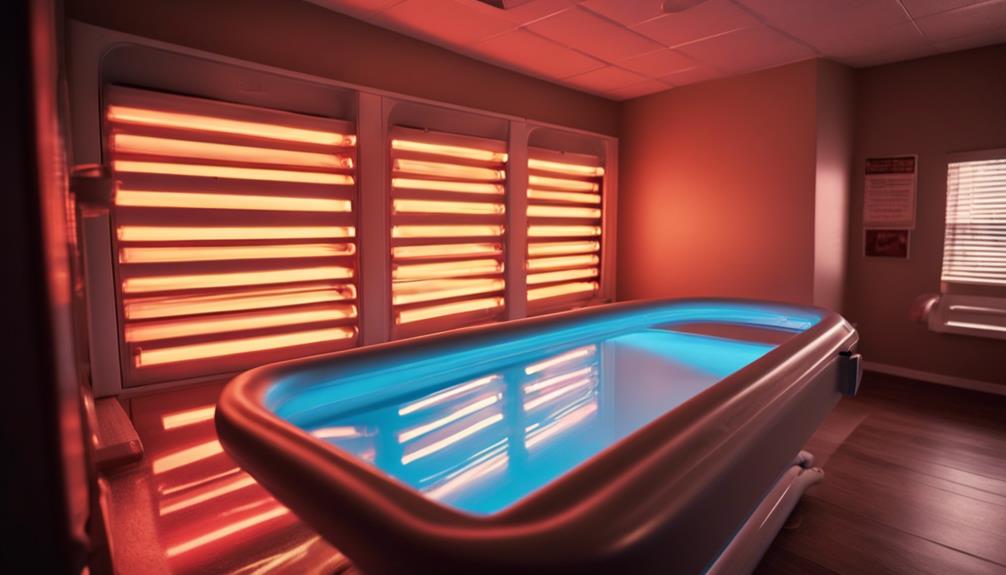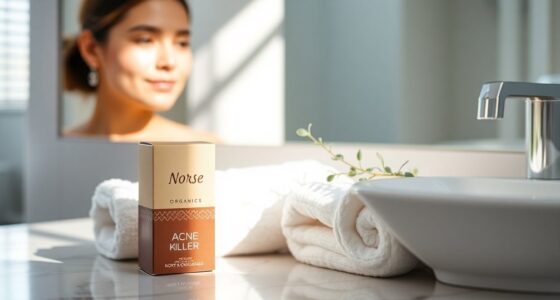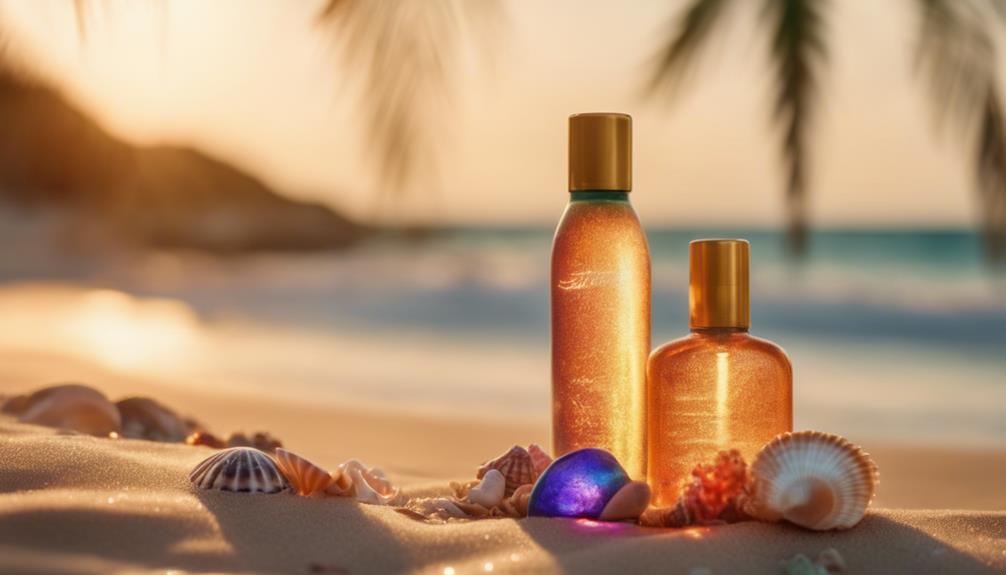To master the art of flawless tanning, start by identifying your skin type. Whether you've got normal, dry, oily, or sensitive skin, selecting the right products is essential. Exfoliate and moisturize before tanning for a smooth base. Use nourishing bronzers for dry skin and powder bronzers for oil control. Choose sunless products for a safe, streak-free tan. Always apply broad-spectrum SPF to protect your skin. After tanning, hydrate and use a rich moisturizer to maintain your glow. Avoid common mistakes like skipping exfoliation and overexposure. There's so much more to perfecting your tan, so keep going to uncover deeper tips!
Key Takeaways
- Identify your skin type to choose the right tanning products for optimal results, such as creams for dry skin and powders for oily skin.
- Exfoliate and moisturize before tanning to ensure a smooth application and prevent patchiness.
- Use broad-spectrum SPF and protective gear to safeguard your skin during tanning sessions, regardless of the method chosen.
- Apply a rich post-tan moisturizer with nourishing ingredients to lock in color and hydration, enhancing your tan's longevity.
Understanding Skin Types
Understanding your skin type is vital for selecting the right tanning products that will enhance your natural glow without causing damage.
Begin by evaluating whether your skin is normal, dry, oily, or sensitive. If you have normal skin, you can use a variety of products to achieve a radiant look.
For dry skin, choose nourishing bronzers infused with ingredients like Sugar Cane and Sweet Almond Oil to lock in moisture. Oily skin benefits from powder bronzers that offer a matte finish.
Regardless of your type, exfoliating and moisturizing before tanning is important for a smooth application.
Selecting Tanning Products
Choosing the right tanning products is essential for achieving a natural glow that complements your skin tone.
Start by evaluating your skin type; cream bronzers work well for dry skin, while powder bronzers suit oily skin, providing a matte finish. If you prefer buildable coverage, liquid bronzers offer customizable results. For a subtle hint of color, gel bronzers are perfect for those natural days.
Always opt for bronzers with clear DHA and natural ingredients like Sugar Cane and Sweet Almond Oil to guarantee even application and moisture retention.
Don't forget to blend well to avoid harsh lines, and remember that nourishing bronzers, such as Supre Tan Candy Toasted Coconut, enhance your skin's radiance.
Happy tanning!
Tanning Methods Overview

When it comes to tanning methods, knowing your options can help you achieve a flawless look while guaranteeing safety and effectiveness.
You've got several choices, from traditional tanning beds to innovative sunless products. Tanning beds combine UVB and UVA rays, giving you a balanced tan, while high-pressure beds focus on deeper, longer-lasting results.
If you prefer a quick option, stand-up booths provide even coverage without pressure lines.
Alternatively, sunless tanning products like lotions, sprays, and mousses offer a safe, streak-free tan.
Whichever method you choose, always remember to prioritize safety by using protective gear, and guarantee proper maintenance of equipment for the best results.
Skin Protection Essentials
Protecting your skin during tanning sessions is vital to prevent damage and maintain its health. Always apply a broad-spectrum SPF tailored to your skin type before tanning. This shields you from harmful UV rays while allowing for a gradual tan.
Don't forget to wear protective gear like goggles and face covers to safeguard sensitive areas. Additionally, opt for lip balm with SPF to keep your lips hydrated and protected from chapping. Wearing a hat can further shield your face from excessive sun exposure.
Post-Tan Care Tips
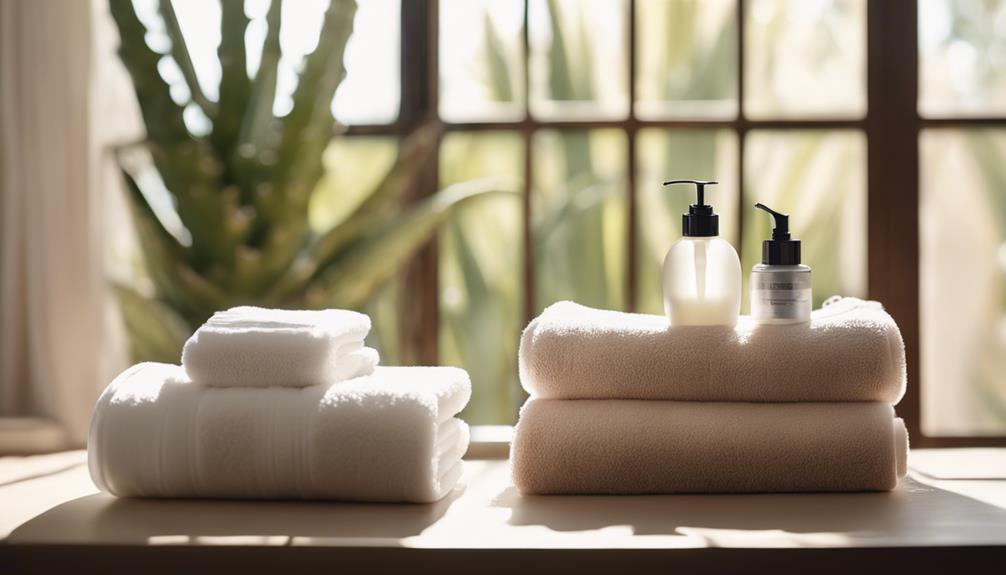
After ensuring your skin is shielded during tanning, it's important to care for it afterward to maintain that radiant glow.
Start by applying a rich post-tan moisturizer to lock in color and keep your skin hydrated. Look for products containing nourishing ingredients like Cocoa Complex and Sweet Almond Oil, which help to enhance your skin's texture.
Avoid hot showers and harsh soaps, as they can strip away your tan; instead, opt for lukewarm water.
Exfoliating is essential, but wait at least 48 hours post-tan to avoid fading. Additionally, drink plenty of water to keep your skin hydrated from within.
Managing Tanning Sessions
Managing your tanning sessions effectively guarantees a beautiful and safe tan while minimizing the risk of overexposure.
Start with shorter sessions and gradually increase the duration to build a base tan without damaging your skin. Use timers or apps to keep track of your tanning time, ensuring you don't exceed recommended limits.
Always monitor your skin for signs of overexposure, like redness or itchiness, and take immediate action if you notice any discomfort. Stay hydrated during and after your sessions, as dehydration can lead to further skin issues.
Avoid heavy makeup before tanning, and consider patch testing your products to prevent sensitivities.
Common Mistakes to Avoid
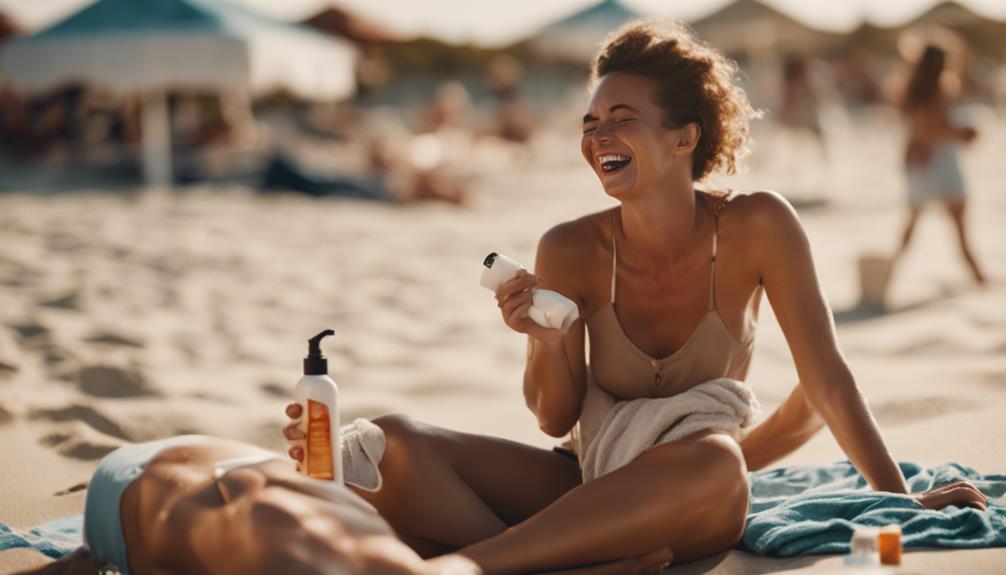
Many people make common mistakes that can hinder their tanning results and compromise skin health.
First, skipping exfoliation leads to uneven application and patchy color. Always prep your skin for a smooth base.
Next, using the wrong product for your skin type can result in poor results—choose wisely!
Overexposing your skin in tanning beds or under the sun is another big mistake; always start with shorter sessions and build gradually.
Forgetting to apply sunscreen during outdoor tanning can cause serious damage, so protect your skin!
Finally, neglecting aftercare isn't wise; use moisturizers to lock in your tan and keep your skin hydrated.
Avoid these pitfalls, and you'll achieve a flawless tan while maintaining healthy skin!
Frequently Asked Questions
Can I Tan if I Have Sensitive Skin?
Yes, you can tan with sensitive skin, but be cautious. Choose gentle products, like natural bronzers, and always patch test. Start with short sessions, monitoring your skin closely for any irritation or discomfort.
How Often Should I Exfoliate Before Tanning?
You should exfoliate your skin 1-2 times a week before tanning. This helps remove dead skin cells, ensuring a smooth application and even tan. Just remember to moisturize afterward to keep your skin hydrated.
Do Tanning Products Expire?
Yes, tanning products do expire. Check the expiration date on the packaging, and if it's past, don't use it. Expired products can lead to uneven results and potential skin irritation, so always prioritize your skin's health.
Can I Tan While Pregnant or Nursing?
You shouldn't tan while pregnant or nursing, as skin sensitivity increases and certain products might pose risks. It's best to consult your doctor for safe alternatives that won't harm you or your baby.
What Should I Wear During a Tanning Session?
You'll feel like a sun-kissed goddess in your best swimwear during a tanning session! Opt for light, breathable fabrics that won't cling, and don't forget protective gear to keep your skin safe and radiant.
Conclusion
Now that you've revealed the secrets to flawless tanning, remember that achieving a radiant glow isn't just about color; it's about confidence.
Like a painter with a canvas, you hold the brush to your beauty, creating a masterpiece that reflects your unique self.
By taking care of your skin and using the right techniques, you'll not only shine but also feel empowered.
So go ahead, embrace your bronzed glow, and let your inner light shine through!

